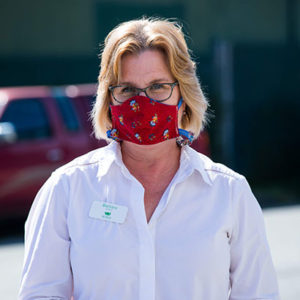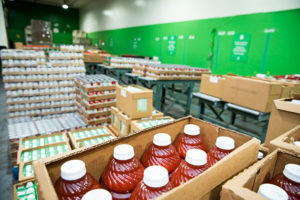 Most of us try to limit our trips to the grocery store – trying to make it in and out as quickly as possible to protect everyone’s health. But when we venture out, it’s hard to miss the shortages and increased prices – it can seem like the bill keeps going up even as we can never get everything on the list.
Most of us try to limit our trips to the grocery store – trying to make it in and out as quickly as possible to protect everyone’s health. But when we venture out, it’s hard to miss the shortages and increased prices – it can seem like the bill keeps going up even as we can never get everything on the list.
At the Food Bank, we’re feeling it too, as Barbara Abbott, Vice President of Supply Chain can tell you. “The pandemic has been like a giant wrecking ball through our food supply chain.”
Barbara is something of an air traffic controller here at the Food Bank, overseeing the sourcing and moving of food from the growers and packers to our warehouse before it heads out to the community.
Grocery Prices Spike
“The general public has seen many of the same things we have at the Food Bank – like a spike in the price of eggs – a whopping 16%. There has been a shortage of meat. And the cost for pre-packaged rice, beans, and other pantry staples has gone up, and grocery shelves are often bare as folks stock up.”
According to the latest report from the Bureau of Labor Statistics, we’ve had the largest one-month price spike for food in nearly fifty years. Overall, food prices climbed an average of 2.6%, the highest increase since February 1974. Two-point-six percent might not seem like a lot, but when your family is stretching the dollar to put food on the table, every penny is accounted for.
Decreased in Supply & Increased Demand
To make matters worse, the Food Bank has moved away from buying grain and other items in bulk. Since the virus is airborne, we simply can’t have staff and volunteers working side-by-side in small sorting rooms. This means not only are we spending more on pre-packed goods, but we are now competing with grocery stores and everyday consumers for family-sized portions of many staples.
These operational challenges have collided with a huge spike in the need we are seeing in our community – we are now serving 62,000 households each week, up from 32,000 pre-pandemic.
 “We’ve had to re-engineer our operations in so many ways,” Barbara said. “But the biggest change is that we’re serving nearly double the number of families with so many of our neighbors out of work.”
“We’ve had to re-engineer our operations in so many ways,” Barbara said. “But the biggest change is that we’re serving nearly double the number of families with so many of our neighbors out of work.”
To meet the need, we not only need more food, but we must find additional storage space, hire more warehouse staff, procure more trucks, and hire more drivers.
As Barbara explained, “the increased need plus higher food prices is really the perfect storm to create shortages.”
However, thanks to the outpouring of generosity from donors, the Food Bank has been able to rise to the challenge. We are ensuring every family receives fresh produce, healthy grains and beans, and high-quality protein.
“We can’t predict when this pandemic will end,” Barbara reflected. “Right now, we are sprinting–but we know this crisis will be a marathon. We are counting on our supporters to make sure the Food Bank can respond to our community’s needs.”


Share